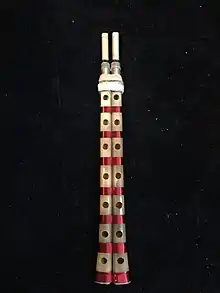Dozaleh
Dozaleh (Persian: دوزَله) is as Iranian-Kurdish folk instrument.[1][2] The dozaleh is made of two pipes.[2] One of them produces melody and the other harmony.[2] It sounds like a Ney-anbān and it is very dynamic.
 Iranian-Kurdish instrument with reed body | |
| Woodwind instrument | |
|---|---|
| Classification | aerophone |
| Hornbostel–Sachs classification | 422.22 Single reed instruments, sets of clarinets (The pipe has a single 'reed' consisting of a percussion lamella) |
| Playing range | |
| One to two octaves | |
| Related instruments | |
Names
The instrument is called Dozaleh (دو زَله) in Kurdistan, from zal (زَل), the Kurdish word for the stem of the zal reed.
The instrument goes by a variety of names in Iran. It is known as Jannati (Persian, "pair": جفتی) in Hormozgan, Do Ney (Persian, "two reeds": دو نی) in Lorestan, Do Sazeh (Persian, "two structures": دو سازه) in South Khorasan Province, and Ghoshmeh (Persian: قوشمه) among Khorasan's Kurdish people.[3]
Ghoshmeh may have come from the tradition of making the instruments from the bones of birds, although one linguist suggests other possibilities, including "pair."[4]
Ghoshmeh
 Ghoshmeh. (قشمه استخوانی "Bone ghoshmeh"). Instrument made from bird bones
Ghoshmeh. (قشمه استخوانی "Bone ghoshmeh"). Instrument made from bird bones Aluminum-bodied instrument (قوشمه از جنس آلمینیوم "Ghoshmeh made of aluminum")
Aluminum-bodied instrument (قوشمه از جنس آلمینیوم "Ghoshmeh made of aluminum") Image showing location of eagle bones used to make the Ghoshmeh and the bones in the polishing stage.
Image showing location of eagle bones used to make the Ghoshmeh and the bones in the polishing stage. Musician Ghanbar Rastgoo playing Hormozgan's version of the "Saz" (instrument, ساز) + "gifti" (paired, جفتی). (Saz gifti, paired instrument, ساز جفتی).
Musician Ghanbar Rastgoo playing Hormozgan's version of the "Saz" (instrument, ساز) + "gifti" (paired, جفتی). (Saz gifti, paired instrument, ساز جفتی).
History
Dozaleh or (Donay in Kurdish) is a very old instrument that is one of the first Iranian wind instruments. In Kurdish areas, this instrument is made from a plant called Zaleh, which grows near river.
In modern times, the instrument's body has also been made from aluminum or copper tubes.[2]
The instrument has been seen as sufficiently important to Iranian culture and history to encourage interest in it, through placement on the Iran National Heritage List. It is placed in works of North Khorasan in the "field of intangible cultural heritage", item 1543: Techniques and skills of making Ghoshmeh local instrument.[5]
Playing
 Alidoost Falahati |
This instrument has 5 to 7 holes in each reed.[6] It is played by three middle fingers of both hands, which are placed on the holes of the instrument.[2] The thumbs take the instrument from behind.[2] The musician puts the instrument's reed "tongue" inside his mouth and blows into it.[2]
See also
Wikipedia
- دوزله Dozaleh in Persian Wikipedia
- قوشمه Ghoshmeh in Persian
- Qoşme (aleta muzîkê) Qoşme in Kurdish Wikipedia
References
- ارفع اطرایی(Arfa Atraei); محمدرضا درویشی (Mohammad Reza Darvishi) (2015). Book of Iranian instrumentation (کتاب سازشناسی ایرانی). Technical and Vocational Education, Lesson Number 4036 (in Persian). Islamic Republic of Iran: Department of Arts, Services, Planning and Supervision. pp. 163–165.
- "گزارشی در رابطه با ساز "دوزله" و موسیقی کردی در ایلام (translation: A report on the instrument "Dozleh" and Kurdish music in Ilam)". Asoroj Media Corporation.
...among which "Dozleh" or Jaftan is one of the musical instruments of Kurdish regions, especially in Ilam province, which is now being forgotten over time. The Kurds of Iran have a very rich music...Dozle and Paftan are two-voiced and have the ability to accompany polyphonic instrument...
- "دوزَله (translation: dozaleh)". iranantiq.com.
- Səid Baykal (1999). "(Translation: Linguistic analysis of the word "Ghoshmeh" - Dr. Hassan Satayesh)". AznewsTV.
Regarding the name of Ghoshmeh in the book of North Khorasan music by Houshang Javid, it is stated: This instrument is made of reed, wood, pen of Derna or falcon and the best type of it is made of "Ghosh" wing bone and for this reason "Ghosh Reed" It has been named, which over time has evolved into a colloquial and slang word "Qushmeh" and "Qushmeh" (p. 121)...
line feed character in
But the word Ghoshmeh is specially made from the Turkic culture of North Khorasan. "Qawsh" / qoʃ / Ibn Mazareh from the source Qoshmagh / qoʃmaɣ / means to pair and join together, and Qushmah is grammatically placed in the category of nouns of the passive noun type; It means "paired and connected" which has been chosen as the name for the musical instrument in question in this region.|quote=at position 372 (help) - "9 ميراث معنوي خراسان شمالي ثبت ملي شد (translation: The spiritual heritage of 9 North Khorasan was nationally registered)". Islamic Republic News Agency.
(translated webpage: https://aekew74e75h334ppkr5adsgcja-adwhj77lcyoafdy-www-irna-ir.translate.goog/amp/83233610/
- "مقاله خبرگزاری ایسنا (Translation: The traditional "Dozle" instrument that was nationally registered.)". Iranian Students' News Agency.
- Hamshahrionline (Persian: همشهری آنلاین), online version of the Hamshahri Iranian daily paper. Article from 20 February 2017: Familiarity with Dozle instrument (آشنایی با ساز دوزله)
- Global Minstrels: Voices of World Music. Elijah Wald. 2012. p. 227. ISBN 9781135863685.

.jpg.webp)

